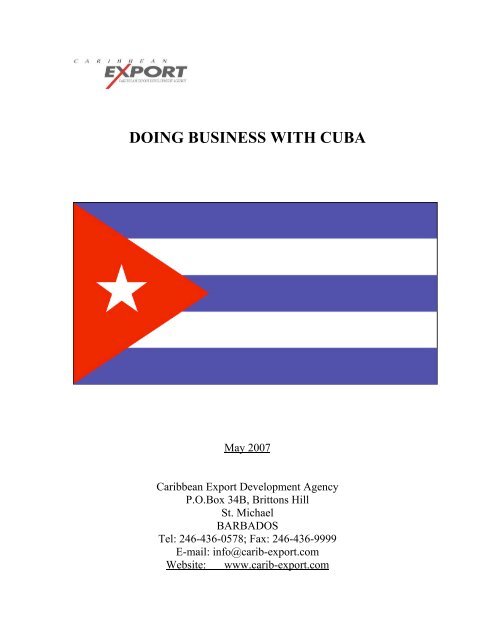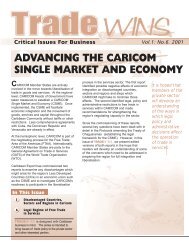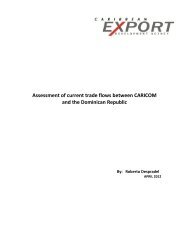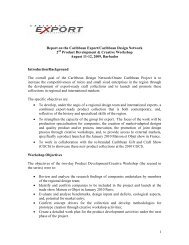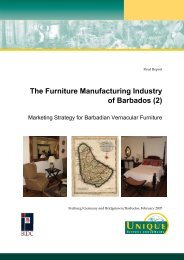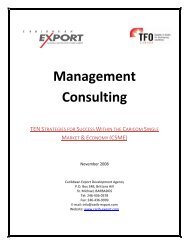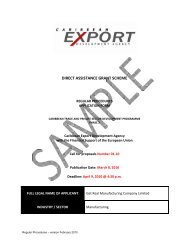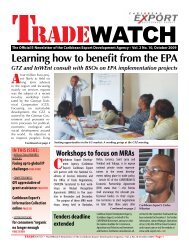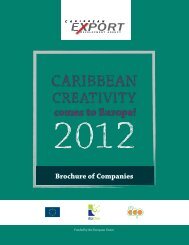doing business with cuba - Caribbean Export Development Agency
doing business with cuba - Caribbean Export Development Agency
doing business with cuba - Caribbean Export Development Agency
Create successful ePaper yourself
Turn your PDF publications into a flip-book with our unique Google optimized e-Paper software.
DOING BUSINESS WITH CUBA<br />
May 2007<br />
<strong>Caribbean</strong> <strong>Export</strong> <strong>Development</strong> <strong>Agency</strong><br />
P.O.Box 34B, Brittons Hill<br />
St. Michael<br />
BARBADOS<br />
Tel: 246-436-0578; Fax: 246-436-9999<br />
E-mail: info@carib-export.com<br />
Website: www.carib-export.com
DOING BUSINESS WITH CUBA<br />
TABLE OF CONTENTS<br />
1. GENERAL INFORMATION..................................................................................... 3<br />
2. THE ECONOMY........................................................................................................ 6<br />
2.1 Structure of the Cuban Economy........................................................................ 6<br />
2.2 Recent Economic Performance........................................................................... 8<br />
2.3 Economic Outlook .............................................................................................. 9<br />
2.4 Overview of Trade .............................................................................................. 9<br />
3. GENERAL MARKETING FACTORS.................................................................... 11<br />
3.1 Distribution and Sales Channels ....................................................................... 11<br />
3.2 Use of Agents and Distributors......................................................................... 11<br />
3.3 Payment Conditions.......................................................................................... 11<br />
3.4 Transportation................................................................................................... 12<br />
4. MARKET ACCESS ISSUES ................................................................................... 13<br />
4.1 Customs Tariff .................................................................................................. 13<br />
4.2 Non-Tariff Barriers ........................................................................................... 14<br />
4.3 Labelling and Marking Requirements .............................................................. 14<br />
4.4 Laws on Patents, Trademarks and Copyright ................................................... 15<br />
4.5 Documentary Requirements.............................................................................. 15<br />
5. INVESTMENT POLICY.......................................................................................... 16<br />
5.1 <strong>Export</strong> Processing Zones................................................................................... 16<br />
5.2 Cuba – <strong>Caribbean</strong> Relations.............................................................................. 16<br />
6. CULTURAL PRACTICES....................................................................................... 18<br />
6.1 Business Customs ............................................................................................. 18<br />
6.2 Entry Requirements .......................................................................................... 18<br />
2
1. GENERAL INFORMATION<br />
Official Name: Cuba<br />
Area: 110 860 square<br />
kilometers (44 210 square miles).<br />
Capital: Havana<br />
Other Cities: Santiago de Cuba,<br />
Camagüey, Santa Clara, Holguin,<br />
Guantanamo, Matanzas, Pinar del Rio.<br />
Population: 11 million<br />
Official Language: Spanish<br />
Life Expectancy: 77 years<br />
Workforce: 4.7 million.<br />
GDP Per Capita: US$3 300.<br />
Currencies: Convertible pesos, Cuban<br />
Peso.<br />
Exchange Rate: US $1 = 0.90<br />
Convertible Peso.<br />
Geography: Cuba is located 90 miles<br />
south of Florida. Its geographic position<br />
is 21 ‘30N, 80 00W. The island lies east<br />
of the Yucatan Peninsula and in one of<br />
the busiest shipping lanes for ships<br />
leaving the Panama Canal for the ports<br />
in North America and Europe.<br />
With a land space of 4 420 square miles<br />
(110 860 square kilometers), Cuba is the<br />
largest island in the <strong>Caribbean</strong>. It is for<br />
the most part flat <strong>with</strong> gently rolling hills<br />
and wide fertile plains. The Sierra<br />
Mountain range reaches a height of 6<br />
500 feet.<br />
DOING BUSINESS WITH CUBA<br />
3<br />
This former Spanish ruled island<br />
attained its independence in 1898.<br />
Population: With a population of over<br />
11 million people, Cuba is one of the<br />
most populous islands of the <strong>Caribbean</strong>.<br />
In terms of ethnicity, about 51 percent of<br />
the Cuban population is mulatto, 37<br />
percent is white, 11 percent black and<br />
one percent Chinese.<br />
At least 70 percent of the population<br />
lives in urban areas and the other 30<br />
percent is located in the rural areas of the<br />
country. The official language is<br />
Spanish.<br />
Education: Considered one of the key<br />
successes of the Cuban Revolution,<br />
Cuba prides itself on its attainment in<br />
this field. The Government spends<br />
enormous sums of money on education<br />
and the results have been significant.<br />
Education is compulsory and free for<br />
children aged six years to 14 years.<br />
Higher education, including university<br />
education, is tied to the country’s<br />
economic and social agenda. It is based<br />
on technology, agriculture, tourism,<br />
medicine, research, and teacher training.<br />
At 97 percent, Cuba has one of the<br />
highest literacy rate in the Western<br />
Hemisphere. Several <strong>Caribbean</strong> students<br />
are presently enrolled at Cuban<br />
universities.<br />
Health: Like Education, the<br />
Cuban Government allocates enormous<br />
resources annually to the health sector.<br />
This area of the Cuban economy is<br />
another success of the Revolution. There<br />
are approximately 300 hospitals, more<br />
than 16 000 alternate medical care<br />
institutions, close to 100 000 beds, 100
000 doctors and a similar number of<br />
nurses. Social welfare benefits are<br />
provided for all categories of illnesses,<br />
disability and unemployment. Cuban<br />
trained doctors are presently working in<br />
a number of countries in the <strong>Caribbean</strong>,<br />
and expertise is provided in a number of<br />
areas. Life expectancy in Cuba is 77<br />
years.<br />
Climate: The climate in Cuba is<br />
similar to that of the Eastern <strong>Caribbean</strong><br />
islands. The rainy season is from May to<br />
October. The island lies in the path of<br />
hurricanes and during the rainy season<br />
especially from June, the island is<br />
subjected to hurricane activity. The dry<br />
season is from November to April.<br />
Religion: The majority of Cubans<br />
are Catholic. There is in Cuba an<br />
umbrella church body, the Cuban<br />
Council of Churches which embraces 22<br />
denominations including Presbyterians,<br />
Episcopalians and Methodists. However,<br />
another 31 officially recognized<br />
denominations include Jehovah<br />
Witnesses and the small Jewish<br />
Community, are not members of the<br />
CCC.<br />
Political System: Cuba is a<br />
Communist country. That system was<br />
installed following the 1959 Revolution<br />
which brought Dr. Fidel Castro Ruz to<br />
power. He has ruled Cuba since then,<br />
until he became ill in 2006. The country<br />
is a one party state <strong>with</strong> the Cuban<br />
Communist Party being the only one of<br />
significance. The country is divided into<br />
14 provinces, including the City of<br />
Havana and one special municipality,<br />
Isle of Youth.<br />
Cuba has had a tempestuous relationship<br />
<strong>with</strong> the United States. The USA has<br />
DOING BUSINESS WITH CUBA<br />
4<br />
imposed an embargo which not only<br />
prevents Americans from trading and<br />
travelling to the island, but frowns on<br />
countries which have been <strong>doing</strong> so.<br />
From time to time the United States had<br />
tightened the embargo and has gone so<br />
far by implementing what is known as<br />
the Helms Burton Act which threatens to<br />
sanction countries <strong>doing</strong> <strong>business</strong> <strong>with</strong><br />
Cuba.<br />
Airports: The country has 11<br />
airports. The Jose Marti International<br />
Airport in Havana is the main one.<br />
Others <strong>with</strong> international air links are<br />
located at Camaguey, Ciego de Avila,<br />
Cienfuegos, Matanzas, Santiago de Cuba<br />
and Varadero.<br />
Air services come mainly from Europe,<br />
Canada, Central and South America,<br />
Mexico and from the <strong>Caribbean</strong> via<br />
Jamaica.<br />
Among the airlines servicing Cuba are<br />
Iberia, Air Jamaica, Air Canada, Virgin<br />
Atlantic, Aeroflot, Lufthansa, Martinair,<br />
ALM-KLM and Cubana. Some smaller<br />
private airlines operate regular services<br />
into the country. Cubana also operates<br />
internal flights in Cuba.<br />
Telecommunications:<br />
Telecommunications are not as<br />
developed. Telephone line density is low<br />
at 10 per 100 inhabitants. The country<br />
has under 900 000 telephone subscribers,<br />
or 7.50 per 100 inhabitants, based on<br />
information from the International<br />
Telecommunications Union.<br />
However, upgrades are taking place. An<br />
Italian firm has completed a national<br />
fibre-optic system to enhance both teledensity<br />
and coverage.
Weights and Measures: According to<br />
the Cuba Chamber of Commerce,<br />
decimal metric system for Weights and<br />
measure is used in the country. Liquids<br />
are measured in litres.<br />
Electric currents: The most widely<br />
used is the single phase 110/60 hertz. In<br />
hotels there is usually the 220v<br />
connection. Points must be flat.<br />
Public Holidays in Cuba<br />
January 1 Liberation Day<br />
January 2 Victory of the Armed<br />
Forces<br />
May 1 International Workers<br />
Day<br />
July 25 Eve of revolution Day<br />
July 26 Anniversary of the<br />
Moncada Barracks Attack<br />
Day<br />
July 27 Revolution Day<br />
October 10 Commencement of Wars<br />
of Independence<br />
December 10 Independence Day<br />
December 25 Christmas Day<br />
DOING BUSINESS WITH CUBA<br />
5
2. THE ECONOMY<br />
2.1 Structure of the Cuban<br />
Economy<br />
2.1.1 Tourism<br />
Tourism is the major sector in the Cuban<br />
economy. This came about after the<br />
country was forced to restructure its<br />
economy following the collapse of the<br />
Soviet Union and the dismantling of<br />
Communism both of which impacted<br />
negatively on the economy. Previously<br />
dominated by sugar, the economy was<br />
opened up to foreign investment. Among<br />
the investors were a number of hotel<br />
companies which entered joint venture<br />
arrangements <strong>with</strong> the Government to<br />
construct hotels. Today Cuba welcomes<br />
in excess of two million visitors and<br />
tourism accounts for over 60 percent of<br />
Gross Domestic Product. The majority<br />
of visitors to the island originate from<br />
Canada, followed Mexico, Europe<br />
(mainly Spain), Latin America and the<br />
<strong>Caribbean</strong>.<br />
2.1.2 Agriculture<br />
This sector was the mainstay of the<br />
economy for over 30 years following the<br />
Cuban revolution of 1959. The principal<br />
agricultural activity was sugar<br />
production as Cuba had a guaranteed<br />
market in Eastern Europe for sugar, the<br />
main export outlet for the commodity.<br />
However, <strong>with</strong> the loss of Eastern<br />
Europe following the political changes<br />
which resulted in those countries<br />
attaining their independence from the<br />
Soviet Union, the industry experienced<br />
declines. Although production is lower,<br />
DOING BUSINESS WITH CUBA<br />
6<br />
Cuba is still a major producer of sugar,<br />
and it exports the commodity to some<br />
markets in Europe and to China. It is<br />
involved in a deal <strong>with</strong> Venezuela where<br />
Cuban sugar is exchanged for oil from<br />
that country. Nonetheless, the Cuban<br />
government is looking to attract foreign<br />
investment in the sugar industry in an<br />
attempt to lift production.<br />
2.1.3 Nickel<br />
Production is on the increase. Along<br />
<strong>with</strong> tourism, nickel output has boost<br />
economic growth to around 11 percent<br />
and 12 percent respectively in 2005 and<br />
in 2006. Venezuela and China have<br />
invested heavily in this segment of the<br />
Cuban economy and Cuba is now the<br />
world’s fifth largest producer of nickel<br />
and cobalt.<br />
2.1.4 Manufacturing<br />
This is another segment of the Cuban<br />
economy which has contributed to the<br />
economic recovery following the<br />
difficult years of the early 1990s. The<br />
production of food and beverage,<br />
chemicals, cement, tobacco, clothing and<br />
textiles, and pharmaceuticals, are some<br />
of the principal goods manufactured by<br />
the <strong>Caribbean</strong> island. The country has<br />
also been exporting these items to<br />
markets in Europe, Canada, Latin<br />
America and China.<br />
2.1.5 Construction<br />
Construction activity in Cuba continues<br />
to be robust, according to the 2006<br />
Economic Report as outlined by the<br />
Government. Foreign investment in the<br />
tourism sector has meant a wave of new<br />
hotel construction to boost the island’s<br />
hotel room stock. In early 2007 the
Cuban Government revealed plans for<br />
improvements to the country’s airport<br />
infrastructure that would benefit the<br />
tourism industry. With capital inflows<br />
from China and Venezuela, the Cuban<br />
government has also undertaken a major<br />
programmeme to build between 250 000<br />
to 300 000 houses as part of the housing<br />
development programmeme in the<br />
country. This activity which is expected<br />
to last three years (2005 – 2007) will add<br />
more buoyancy to construction activity<br />
whose contribution to GDP is around<br />
seven percent.<br />
2.1.6 Oil<br />
The oil industry in Cuba is expanding.<br />
Previously, Cuba had received its oil<br />
supplies from the then Soviet Union at<br />
concessionary prices. However, this was<br />
subsequently suspended in the early<br />
1990s when the Soviet Union was<br />
disintegrated.<br />
This had disastrous effects on the<br />
<strong>Caribbean</strong> island. With energy shortages,<br />
electricity was rationed, industrial output<br />
declined, public transportation was<br />
disrupted and there constant blackouts in<br />
the country. The Government<br />
subsequently looked for ways to<br />
stimulate the oil industry by inviting<br />
foreign investment in the sector. This<br />
has paid dividends While Venezuela is<br />
now the main supplier, the domestic<br />
industry is presently supplying 20<br />
percent of local requirements.<br />
2.1.7 Pharmaceutical<br />
The Pharmaceutical industry in Cuba<br />
continues to make strides.<br />
Biotechnology and indigenous<br />
technologies are the main areas driving<br />
this area of the Cuban economy.<br />
DOING BUSINESS WITH CUBA<br />
7<br />
Estimates suggest that while the industry<br />
saves the country in excess of US$60<br />
million in imports annually, it also<br />
maximizes earnings through the export<br />
of medicines and prescription drugs to<br />
about 30 countries, including some in<br />
Latin America. Research is also taking<br />
place to produce new pharmaceuticals<br />
products for the export market.<br />
Table 1. Sectoral Contribution to GDP in<br />
2006<br />
Sector %<br />
Tourism 67<br />
Manufacturing 15<br />
Construction 7<br />
Agriculture and Fisheries 5<br />
Mining 1.5<br />
2.1.8 Banking<br />
The Central Bank of Cuba is at the apex<br />
of the banking system in the country.<br />
First established in 1948 as the National<br />
Bank of Cuba, this institution was<br />
reorganized on at least four occasions,<br />
the last being in 1997 when it became<br />
the Central Bank. Its President is a<br />
member of the Council of Ministers of<br />
Cuba.<br />
The financial system is made up of eight<br />
commercial banks, an investment bank,<br />
and non-bank financial institutions. The<br />
Havana Investment Bank is registered in<br />
London. There are no stock exchanges.<br />
The Cuban Central Bank performs<br />
traditional central banking operations –<br />
issuing currencies, managing the<br />
financial system and the economy,<br />
specifying monetary policy, and acting<br />
as lender of last resort. Because of the<br />
American economic embargo the Central
Bank has been very vigilant in<br />
maintaining the stability of the Cuban<br />
currency to ensure there are no economic<br />
shocks.<br />
2.1.9 Exchange Rate<br />
Cuba has two currencies in circulation:<br />
the Cuban Peso (CUP) and the<br />
convertible Peso. In April 2005 the<br />
official exchange rate was adjusted from<br />
US$1 per CUP to US$1.08 to CUP, both<br />
for individuals and enterprises. Cuba<br />
levies a 10 percent charge on each<br />
conversion of US dollars to CUP.<br />
Cuban peso is used by government wage<br />
earners for subsidized goods and<br />
services, while the convertible peso is<br />
used for the purchase of consumer goods<br />
not available in peso stores or in the<br />
government ration. The Cuban peso is<br />
tied to several major foreign currencies,<br />
including the Euro, initially making for<br />
an eight percent revaluation.<br />
2.2 Recent Economic Performance<br />
2.2.1 Economic Indicators (2006)<br />
National currency: Peso. Exchange rate<br />
US$1 = 0.93 peso<br />
Table 2 Balance of Payments<br />
Balance of Payment<br />
Gross Domestic Product 36.2 billion<br />
<strong>Export</strong>s 2.0 billion<br />
Imports 7.5 billion<br />
GDP per capita 3300<br />
hundred<br />
Inflation Rate 5.0 %<br />
DOING BUSINESS WITH CUBA<br />
8<br />
2.2.1 Prices and Income<br />
Consumer prices as measured by the<br />
Retail price Index have been fluctuating<br />
in Cuba. From seven percent in 2003,<br />
the inflation rate declined in the two<br />
following years, before increasing in<br />
2006. However, prices are projected to<br />
moderate in 2007 to about five percent.<br />
Inflation in Cuba is determined by the<br />
price fluctuation in both the market of<br />
the Cuban Peso and the official market<br />
of convertible pesos.<br />
Table 3. Consumer Price Variation<br />
%<br />
2003 7.1<br />
2004 4.1<br />
2005 3.1<br />
2006 7.0<br />
2007 5.0<br />
2.2.2 Employment<br />
The Cuban Labour Market displays<br />
certain characteristics. Of a population<br />
of 11 million people, the Cuban<br />
workforce is estimated at around six<br />
million. Labour costs are low when<br />
compared to other hemispheric<br />
countries. In 2003 the International<br />
Labour Organization (ILO) estimated<br />
Cubans were earning at least 234 pesos a<br />
month. However, wages of public sector<br />
employees and those <strong>with</strong> university<br />
degrees were increased in 2005, as were<br />
retirement and social pensions, and the<br />
minimum wages.<br />
The point must be made though that<br />
Cuban workers receive free health care<br />
and education from the Government, and<br />
pay nor more than 10 percent of their
incomes for housing. Furthermore, all<br />
Cubans are entitled to a subsidized<br />
monthly food rations.<br />
Another characteristic is that the Cuban<br />
labour force is well educated thereby<br />
creating a pool of trained workers for the<br />
market.<br />
In addition, under a 1993 Labour Law,<br />
the Cuban government adopted a policy<br />
of distributing employment by industry<br />
and occupation. This policy by the<br />
Government means that foreign firms<br />
operating in the country are required to<br />
hire their labour through a state agency.<br />
One drawback from this system is that it<br />
limits the freedom of firms to choose<br />
their own workers.<br />
Table 4 2006 Labour Force by Economic<br />
Sector<br />
Sector %<br />
Agriculture 20<br />
Industry 19.4<br />
Services 60<br />
Total Unemployment 1.9<br />
2.3 Economic Outlook<br />
The Economist Intelligence Unit (EIU)<br />
anticipates that Cuba’s economic future<br />
will be shaped by the successor to Fidel<br />
Castro. The President who is still<br />
recuperating from an illness he suffered<br />
in 2006 has shaped Cuba over the last 47<br />
years. His brother Raul Castro is acting<br />
as President.<br />
However, analysts suggest that a post<br />
Fidel Castro Cuba will most likely make<br />
up <strong>with</strong> the United States. Several<br />
American <strong>business</strong>men have been<br />
DOING BUSINESS WITH CUBA<br />
9<br />
calling on their Government to end the<br />
economic embargo on Cuba, given that<br />
European, Asian, and Latin American<br />
and <strong>Caribbean</strong> firms and individuals, are<br />
<strong>doing</strong> <strong>business</strong> <strong>with</strong> Cuba.<br />
The EIU said that the Cuban Central<br />
Bank will maintain fiscal and monetary<br />
discipline although liberalization will<br />
slow GDP growth. However, it expects<br />
that investments will drive overall<br />
growth, supported by rising household<br />
operations; infrastructure and<br />
manufacturing which it is anticipated<br />
will expand, along <strong>with</strong> some recovery<br />
in agriculture. The current account will<br />
show a small deficit.<br />
Table 5 Economic Outlook<br />
2006 2007 2008<br />
Real GDP Growth (%) 11.1 7.10 5.7<br />
Consumer Price Inflation 6.7 3.6 4.1<br />
Budget Balance (% of GDP) -3.8 -3.2 -2.4<br />
Exchange Rate (US $ : Euro) .93 .93 .90<br />
Source:EIU<br />
2.4 Overview of Trade<br />
2.4.1 <strong>Export</strong>s<br />
Cuba has intensified its exports of goods<br />
and services.<br />
Cuba’s main exports are services<br />
(mainly tourism), sugar, tobacco, nickel,<br />
medical products, citrus fruits and<br />
coffee. <strong>Export</strong>s totaled US$2.5 Billion in<br />
2005, and US$2.8 Billion the following<br />
year. Main export markets are the<br />
Netherlands, Canada, Venezuela, Spain,<br />
China, Russia and France. The country<br />
exports as well to Latin America and the<br />
<strong>Caribbean</strong>
2.1.4 Imports<br />
Petroleum and food account for the<br />
majority of imports into Cuba. They<br />
were estimated at US$2 Billion in 2002.<br />
However, by the end of 2006 the value<br />
of both items imported into Cuba was<br />
US$4 Billion. The main imported food<br />
items include corn, rice, and beans.<br />
Petroleum, machinery and chemicals<br />
also account for a fair share of imports to<br />
the island. Main suppliers are<br />
Venezuela, China, Spain, USA, Canada,<br />
Brazil, Germany, Italy and Mexico.<br />
Imports are handled by Alimport, a state<br />
agency.<br />
Table 6 Cuba’s 2006 Energy Imports<br />
PRODUCT VOLUM<br />
E<br />
UNIT<br />
VALUE<br />
(US$)<br />
Source: 2006 Oficina Nacional de Estadisticas de<br />
Cuba.<br />
2.5 Cuba’s Trade <strong>with</strong> CARICOM<br />
In 2005, Cuba’s domestic exports to<br />
CARICOM were in excess of EC$178<br />
billion, while imports were<br />
DOING BUSINESS WITH CUBA<br />
TOTAL VALUE<br />
($)<br />
LPG 790 225 101.38 79 812 000<br />
Gasolene 281 780 182.58 51 289 000<br />
Jet Kero 1<br />
965<br />
401 182.58 269 184 000<br />
Diesel 7<br />
355<br />
638 180.82 1 383 000 000<br />
Fuel Oil 4<br />
310<br />
706 106.34 498 836 000<br />
Crude Oil 19 423<br />
110<br />
57.37 1 107 115 000<br />
TOTAL<br />
MARKET<br />
VALUE<br />
3 389 227 000<br />
10<br />
approximately EC$48 billion, a trade<br />
surplus in excess of EC$130 billion.
3. GENERAL MARKETING<br />
FACTORS<br />
3.1 Distribution and Sales<br />
Channels<br />
Over last decade or so the Cuban<br />
Government has been pursuing policies<br />
to improve the import and distribution<br />
networks in the country. Retail<br />
operations are run by agencies set up as<br />
corporations by the government, by<br />
foreign corporations (in partnership <strong>with</strong><br />
the Government) or by individuals under<br />
strict licensing and leasing agreement.<br />
Buying and distribution decisions are<br />
made at central headquarters, although<br />
store and department managers are<br />
having inputs into the process.<br />
State-owned companies which are<br />
involved in the importation of goods are<br />
not permitted to advertise products and<br />
services. There are showrooms and<br />
warehouses located in specific places in<br />
the country.<br />
3.1.1 Wholesale Food Distribution<br />
The Cuban Government attaches<br />
considerable importance to the food<br />
distribution network system in the<br />
country. As such it has undertaken a<br />
major overhaul of the system by<br />
strengthening wholesale and retail and<br />
storage capacity and refrigerated<br />
facilities. It has taken control of the<br />
system.<br />
3.1.2 Retail Food Distribution<br />
State agencies have been established to<br />
retail food. Part of the reorganization<br />
process was linking state farms to<br />
cooperatives in the province of Havana<br />
and to produce markets. Apart from state<br />
DOING BUSINESS WITH CUBA<br />
11<br />
bodies, there are some small private<br />
farmers who retail food in Cuba. Some<br />
of these are based in the underground<br />
economy.<br />
3.2 Use of Agents and Distributors<br />
Goods can be imported into Cuba only<br />
by state entities and by joint venture<br />
operations holding permits for the<br />
specific goods in question. While agents<br />
and intermediaries handle goods on<br />
consignment for licensed importers, they<br />
cannot import on their own accord and<br />
neither can they conduct distribution<br />
operations. Joint ventures <strong>with</strong> foreign<br />
participation will generally obtain their<br />
import permits through their Cuban<br />
partners. However, the right to import<br />
specific categories of products may be<br />
included in negotiations when seeking<br />
approval for the joint venture.<br />
3.3 Payment Conditions<br />
Foreign companies are expected to<br />
establish a substantial trade relationship<br />
<strong>with</strong> Cuba for at least three years before<br />
being allowed to set up a presence in the<br />
island. For this reason, consignment<br />
sales have been gaining in popularity.<br />
Goods can be shipped to Cuba under<br />
consignment provided that they are<br />
covered by a contract for sales of<br />
merchandise imported as consignment.<br />
Consignment contracts have to stipulate<br />
that the consignee holds title to the<br />
goods, which the consignee must sell on<br />
behalf of the consignor according title to<br />
the goods, which the consignee must sell<br />
on behalf of the consignor according to<br />
the terms set out in the contract. The<br />
consignee must pay for the goods at the<br />
time they are sold.
3.4 Transportation<br />
A good network of roads, railroads and<br />
air and sea transportation are key<br />
features of Cuba’s infrastructure. Several<br />
ports abound handling tons of export and<br />
import cargo. Cuba lies in a major<br />
shipping lane especially for ships<br />
leaving the Panama Canal and destine<br />
for North America and Europe.<br />
However, again because of the American<br />
embargo ships destining for USA ports<br />
are not allowed to make calls at Cuban<br />
ports.<br />
Apart from oil imports from Trinidad<br />
and Tobago, sea transport links <strong>with</strong><br />
CARICOM are not as fully developed as<br />
<strong>with</strong> some other ports in Central<br />
America.<br />
Nonetheless, Havana, the Cuban capital<br />
and the largest town in the country,<br />
accounts for just over half of all cargo<br />
vessels calling at the island. Other major<br />
ports are Mariel (Free Trade Zone),<br />
Matanzas, Nipe, Nuevitas and Santiago<br />
de Cuba.<br />
DOING BUSINESS WITH CUBA<br />
12
4. MARKET ACCESS ISSUES<br />
4.1 Customs Tariff<br />
4.1.1 General Import Policy<br />
Cuba has gradually opened up its<br />
economy to trade in the face of an<br />
economic embargo the United States has<br />
imposed on the island. The country is<br />
not part of the several hemispheric<br />
integration movements like the<br />
<strong>Caribbean</strong> Community, Central<br />
American Common Market, Latin<br />
American Integration Association and<br />
the Free Trade Area of the Americas.<br />
There are therefore strict rules which<br />
guide the country’s import policy. To<br />
trade <strong>with</strong> Cuba exporters must have two<br />
licenses: a travel license and an<br />
exporting license.<br />
Cuba’s tariff regime is outlined in<br />
Decree Law 124 of 1990. Decree Law<br />
162 of 1996 sets out the functions and<br />
operations of the Custom system.<br />
According to the World Bank, Cuba’s<br />
weighted average tariff rate was 9.4<br />
percent, up from 8.2 percent.<br />
4.1.2 Import Permits<br />
Goods can be imported into Cuba only<br />
by state entities and by joint venture<br />
operations holding permits for the<br />
specific goods in question.<br />
While agents and intermediaries handle<br />
goods on consignment for licensed<br />
importers, they cannot import on their<br />
own accord and neither can they conduct<br />
distribution operations. Import permits<br />
are therefore required.<br />
DOING BUSINESS WITH CUBA<br />
13<br />
Joint ventures <strong>with</strong> foreign participation<br />
will generally obtain their import<br />
permits through their Cuban partners.<br />
But the right to import specific<br />
categories of products may be included<br />
in negotiations when seeking approval of<br />
the joint venture arrangement.<br />
4.1.3 Taxation<br />
Cuba has an income tax rate of 50<br />
percent and a corporate tax rate of 35<br />
percent. The corporate tax rate is levied<br />
on branches in the same way as other<br />
companies. The rate of the progressive<br />
income tax varies from 10 percent (for<br />
those earning less than US$6 000) to 50<br />
percent (for those earning more). While<br />
there is no value added tax in Cuba there<br />
is a tax on sales <strong>with</strong> the rate varying<br />
according to the nature of the products.<br />
The state has both land taxes and<br />
property transfer taxes.<br />
Conversions between the US dollar and<br />
the Cuban convertible peso are subject to<br />
a 10 percent tax. The fiscal year runs<br />
from January 1, to December 31.<br />
4.1.4 Import Duties<br />
It should be noted that Cuba uses the<br />
nomenclature of the harmonized system<br />
up to eight digits. The simple average<br />
tariff on about 5 400 commodities was<br />
lowered from 11.5 percent to 10.4<br />
percent for Most Favoured Nation<br />
(MFN) countries, according to the<br />
Ministry of Foreign Trade. The<br />
maximum MFN tariff is 30 percent.<br />
Cuba applies the MFN rate to goods<br />
originating in countries which have<br />
bilateral agreements. Non MFN general<br />
tariff averages 17.9 percent. Cuba is a<br />
member of the Latin American<br />
Integration Association and input
classifications are based on the<br />
Harmonised Systems at the eight digit<br />
level.<br />
4.1.5 Special Provisions<br />
Entities <strong>with</strong> foreign partners may be<br />
granted duty free status for some or all<br />
of those products as part of their<br />
economic association or joint venture<br />
agreement.<br />
Provision is there for negotiating other<br />
terms of these agreements. There are as<br />
well negotiations for duty drawback in<br />
circumstances including temporary<br />
importation for upgrading or re-exports<br />
and replacement of materials<br />
incorporated in exported products and<br />
chemicals that disappear during the<br />
production process and not incorporated<br />
in the formal product.<br />
However, of note is the fact that these<br />
drawbacks are granted only when the<br />
circumstances are deemed to be in the<br />
national interest or for commercial<br />
viability in foreign markets.<br />
4.1.6 Special Custom Procedures<br />
An approved Cuban Custom Broker<br />
must handle all custom formalities.<br />
Some larger importers arrange to have<br />
staff trained and certified and pay a fee<br />
of US$50 monthly to operate internal<br />
agencies.<br />
Precise documentation and full<br />
compliance <strong>with</strong> all regulations is<br />
essential when exporting products to<br />
Cuba.<br />
Care is urged because seemingly minor<br />
discrepancies can lead to confiscation of<br />
improperly documented imported goods.<br />
DOING BUSINESS WITH CUBA<br />
14<br />
Since labelling, sanitary and<br />
phytosanitary and product safety<br />
standard regulations are enforced at the<br />
border as a practical matter, the burden<br />
of compliance rests <strong>with</strong> all exporters.<br />
4.2 Non-Tariff Barriers<br />
4.2.1 Foreign Exchange Controls<br />
There are no foreign exchange controls<br />
in Cuba. However; from time to time<br />
changes are made to the regulations.<br />
Effective November 8, 2004, the Cuban<br />
Government adjusted the laws relating to<br />
foreign exchange controls. Shops and<br />
other <strong>business</strong>es are no longer allowed to<br />
accept US dollars. Also foreigners<br />
holding US dollars are required to pay a<br />
10 percent fee for convertible pesos.<br />
Previously the convertible pesos were<br />
used interchangeably <strong>with</strong> US dollars.<br />
However, this is no longer the case.<br />
4.3 Labelling and Marking<br />
Requirements<br />
The National Standards Office in Cuba<br />
sets out strict guidelines for labelling all<br />
products exported into Cuba. These<br />
standards are similar to other countries’<br />
regulations. The following are the<br />
guidelines:<br />
• Specific name of the product(s)<br />
• Labels must be in Spanish<br />
• Labels must contain ingredients<br />
of products<br />
• The expiry date must be cited<br />
• Net Content must be listed<br />
• Price<br />
• Quantity of units
In addition, all documents must be<br />
originals and translated in Spanish.<br />
4.4 Laws on Patents, Trademarks<br />
and Copyright<br />
4.4.1 Patents<br />
In Cuba the regulations address the issue<br />
of three patents which have to be applied<br />
for. These are Patent of Invention, Patent<br />
of for a complement of Invention, and<br />
patent for industrial models. Cuba is a<br />
member of the World Intellectual<br />
Property Organization and has its own<br />
body the Cuban Office of Industrial<br />
Property.<br />
The country also subscribes to a number<br />
of international conventions.<br />
4.4.2 Trademarks<br />
All Trademarks and brand names<br />
registered in Cuba are protected under<br />
Cuban Laws. Trademark registration<br />
<strong>with</strong> the Cuban Office of Trademarks<br />
and Patents is voluntary but it is highly<br />
recommended that exporters shipping<br />
products to Cuba make every effort to<br />
register their trademarks and brand<br />
names there.<br />
4.4.3 Copyrights<br />
Cuba is a signatory to many treaties and<br />
agreements, including the Berne<br />
Convention. Based on this factor the<br />
protection of copyrights and inventions<br />
is enshrined in Cuban laws. A very<br />
significant factor as well, is the fact that<br />
Cuba’s economic policy involves<br />
pursuing sectors where research and<br />
product development must be heavily<br />
guarded against infringement.<br />
DOING BUSINESS WITH CUBA<br />
15<br />
Biotechnology, information services,<br />
pharmaceuticals and cultural industries<br />
are among the areas that would be<br />
vulnerable to infringements outside of<br />
the island. As Cuba adheres to<br />
copyrights rules it expects similar<br />
behaviour from other states.<br />
4.5 Documentary Requirements<br />
In shipping goods to Cuba exporters<br />
must have at least two copies of a bill of<br />
laden. Similarly, copies of the Airport<br />
Bill are also required if the goods are<br />
being sent by air. Other documentary<br />
requirements are Commercial Invoice<br />
and Packaging List. Full details about<br />
the origin of the goods, contents and<br />
weight must be identified on the<br />
documents.
5. INVESTMENT POLICY<br />
With the exception of defense, public<br />
health care and education, all other<br />
sectors of the Cuban economy are<br />
opened to Foreign Direct Investment.<br />
Provision for FDI is made under the<br />
country’s Foreign Investment Act of<br />
1993 which outlines broad areas of<br />
investment promotion and incentives for<br />
foreign investors. The areas identified<br />
for FDI are tourism, manufacturing,<br />
nickel and mining, agriculture,<br />
information technology,<br />
pharmaceuticals, and<br />
telecommunication.<br />
These areas where foreign investment is<br />
being invited are among a list outlined<br />
by the Cuban Ministry of Foreign<br />
Investment and Economic Cooperation<br />
and other official agencies of<br />
Government.<br />
The aims of the policy are to diversify<br />
the economy, moving it away from<br />
being dominated by agriculture, and to<br />
earn foreign exchange. The country has<br />
signed Bilateral Investment Treaties <strong>with</strong><br />
other countries to promote investment<br />
and to protect investors. There are no<br />
limits on repatriating profits by foreign<br />
investors and foreign investors are given<br />
protection and special safeguards.<br />
Financing is provided at concessionary<br />
rates and joint ventures are also pursued.<br />
5.1 <strong>Export</strong> Processing Zones<br />
Since 1997 Cuba has in place export<br />
processing zones. Decree Law 165<br />
makes provision for the EPZs which are<br />
located on approximately 1 250 hectares<br />
of land. Considered the largest in the<br />
DOING BUSINESS WITH CUBA<br />
16<br />
<strong>Caribbean</strong> and even surpassing those of<br />
Panama, the Cuban EPZs are located in<br />
Havana, Cienfuegos, and in the Berroa<br />
Valley.<br />
The genesis behind setting up EPZs is to<br />
attract foreign direct investment and to<br />
increase exports, cited a United Nations<br />
Discussion Paper authored by Larry<br />
Willmore. Through Decree Law 165, the<br />
Cuban authorities have granted attractive<br />
concessions for investors wishing to<br />
participate in the EPZs. Investors are<br />
allowed to retain full ownership of their<br />
operations which is different from other<br />
forms of investments are based on joint<br />
ventures <strong>with</strong> public enterprises.<br />
Investors <strong>with</strong> plants in the processing<br />
zones are exempted from Cuban income<br />
tax and taxes on labour utilization for a<br />
period of 12 years to be followed by a 50<br />
percent exemption for another three<br />
years.<br />
While EPZs are primarily designed to<br />
promote exports Cuba allows some<br />
plants limited sales to the domestic<br />
market.<br />
Products that incorporate at least 50<br />
percent Cuban value added are exempted<br />
from the payment of duty. No other<br />
country in the <strong>Caribbean</strong> Basin offers<br />
such incentives for EPZs sales to the<br />
domestic market.<br />
5.2 Cuba – <strong>Caribbean</strong> Relations<br />
In 2000 Cuba and CARICOM signed a<br />
Trade and Economic Cooperation<br />
Agreement. The agreement which has<br />
since been ratified provides for the duty<br />
free entry in each other’s markets of a<br />
list of approved goods. In the meantime,<br />
CARICOM countries have a list of items
they believe hold good prospects in the<br />
Cuban market.<br />
Table 7 CARICOM Products/Services<br />
Which Can Be <strong>Export</strong>ed to Cuba<br />
Aluminium Plastic<br />
Articles<br />
Bread Processed<br />
Foods<br />
Coffee Putty<br />
Condiments Rum<br />
Cut Flowers Rum Cakes<br />
Fish Sauces<br />
Fruits and Vegetables Ships/Boats<br />
Ice Cream Tanks<br />
Leather Goods Tourism<br />
Services<br />
Malta Water<br />
Heating<br />
Systems<br />
Source: Barbados Investment<br />
<strong>Development</strong> Corporation<br />
CARICOM countries are undertaking<br />
<strong>business</strong> and trade missions to Cuba to<br />
secure trade and investment<br />
opportunities.<br />
The Jamaican Hotel Chains, Super Clubs<br />
and Sandals have hotels in Cuba, while<br />
Trinidad and Tobago exports mainly oil<br />
and other energy based products to<br />
Cuba. In September 200t that country<br />
opened a Trade Center in Cuba to further<br />
solidify its commercial relations there.<br />
Barbados has mounted a trade mission to<br />
Cuba and has signed a double taxation<br />
agreement <strong>with</strong> the island.<br />
DOING BUSINESS WITH CUBA<br />
17
6. CULTURAL PRACTICES<br />
6.1 Business Customs<br />
Government: 8.30 a.m. to 12.30 p.m;<br />
1.30 p.m. to 5.30 p.m. (Monday to<br />
Friday); 8.30 a.m. to 12 noon<br />
(alternative Saturdays)<br />
National Bank: 8.30 a.m to 12<br />
noon; 1.30 p.m. to 3 p.m (Monday to<br />
Friday); 8.30 a.m. to 10.30 a.m.<br />
(Saturday).<br />
6.2 Entry Requirements<br />
All travellers to Cuba must possess a<br />
valid passport, a return ticket and a visa<br />
or tourist visa. Tourist visas are issued<br />
by the ticketing airline or travel agents.<br />
In a worse case scenario they can usually<br />
be bought on the spot upon clearing<br />
Customs. Visas cost between CUC $25<br />
and CUC $35, depending upon the<br />
issuing agent. They are good for up to 90<br />
days, although Custom agents will<br />
sometimes issue them for 30 days. Other<br />
requirements are needed for the USA<br />
and other countries. For instance,<br />
CARICOM citizens travelling to Cuba<br />
do not require a visa for vacation trips. A<br />
tourist visa may be required. Business<br />
travelers need a Business Visa.<br />
DOING BUSINESS WITH CUBA<br />
18
APPENDIX<br />
ADDRESSES<br />
Government Regulating Agencies<br />
Ministerio de Salud Publica<br />
Call 23, No 201 entre M y N Vedado<br />
Plazo Revolucion<br />
Habana, Cuba CP 10400<br />
Institute of Natrition and Food Safety<br />
Infanta No. 1158 entre Linas y Clavel<br />
Centro de La Habana<br />
Habana, Cuba CP 10300<br />
Tel: 011 (537) 78-1429, 78-5919, 70-<br />
0183<br />
National Standards Office<br />
Calle E No.261 entre 11 y 13<br />
Vedado – La Habana,<br />
Tel: 011 (537) 30-0022, 30 0835, 30-<br />
0825.<br />
Center for Investment Promotion of<br />
Cuba<br />
Calle Ira Entre 22 y 24<br />
Miramar<br />
Cuidad de La Habana<br />
Tel:537 702-3873.<br />
Center for <strong>Export</strong> Promotion of Cuba<br />
Vedado,<br />
Cuidad de La Habana<br />
Tel:537 55-0428/55 – 460<br />
Ministry of Foreign Trade (MINCEX)<br />
Infanta No. 16 esq.a 23<br />
Vedado Cuidad de La Habana<br />
Tel:537 – 54-3237/38.<br />
Mariel Free Zone<br />
Carretera de Quiebra Hacha<br />
Vista del Mar<br />
Peninsula de Langosta Mariel<br />
Cuidad de La Habana<br />
Tel:537-33-5924/063-98201.<br />
DOING BUSINESS WITH CUBA<br />
19<br />
MEDIA IN CUBA<br />
Newspapers<br />
• Adelanta<br />
• Ahora<br />
• Guerrillero<br />
• Granma<br />
• Juvenlud Rebelde<br />
• Nueva Prensa Cubana<br />
• Trabajadores<br />
• Vanguardia<br />
Radio<br />
• Radio Rebelde<br />
• Radio Reloj<br />
• Radio Habana Cuba<br />
News Agencies<br />
• Agencia de Informacion<br />
Nacional<br />
• Prensa Latina


